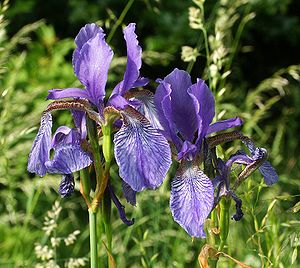Iris sibirica
| Siberian Iris | |
|---|---|
 | |
| Binomial: | Iris sibirica |
| Genus: | Iris |
| Family: | Iridaceae |
| Type: | Perennial |
| Light requirements: | Full sun |
| Water requirements: | Drought tolerant |
| Soil requirements: | Grows in almost any soil |
| USDA Hardiness Zone: | 4-9 |
| Propagation: | Division of rhizomes |
| Pruning season: | Cut back in mid winter |
| Transplant: | Easily transplants, roots should not be buried but rather just placed on the surface |
| Pest issues: | Few |
| Disease issues: | Few |
| Bloom season: | Late spring |
| Harvest: | Cut flowers when freshly opened |
| Weediness: | Can be a problem |
| Height and spread: | 50-120 cm tall |
Iris sibirica, the Siberian Iris, is a flowering plant, native to eastern and central Europe and northern Asia. It is grown for its showy flowers and good foliage, which is narrower and less coarse than many of the other Iris species.
Description
[edit | edit source]Siberian iris is an herbaceous perennial plant growing to 50–120 cm tall. The leaves are glaucous green, narrow and fairly rigid, blade-shaped, 40–80 cm long and 2–4 cm broad. The flowers are typical of an iris, borne in late spring or early summer on unbranched or sparsely-branched stems held above the leaves, each flower 4–7 cm diameter. Flowers of the species are mid- to purple-blue, often with a paler whitish or yellowish centre, though cultivars are sometimes much paler or white.
Growing conditions
[edit | edit source]This iris requires full sun and ample drainage. When planting, the roots should be slightly above the level of the surrounding soil (the exposed edges can be hidden with compost or mulch). They will appreciate composts, but nitrogenous fertilizers will encourage heavy vegetative growth and few flowers.
This plant will not flower in shady locations, and will die in deep shade.
Varieties
[edit | edit source]There are several cultivars selected for flower color and form. Most cultivars of this species are likely hybrids with related species of Iris.
Uses
[edit | edit source]In the garden, siberian iris is commonly grown as an accent plant for its showy flowers and tidy, erect form. The plants are often left up during the winter, as the foliage develops a good color, and the seed pods have ornamental interest.
The long-stemmed flowers are often harvested for the vase as a fresh flower. The seed pods are also used in winter arrangements.
Maintenance
[edit | edit source]After a few years growing in the garden, Siberian iris will develop a "hollow center", growing in a ring around the old roots. The foliage then begins to point outwards, losing some of its ornamental appeal. When the hollow center develops, simply dig up and divide the plant after flowering.
The foliage can be left up for winter interest, but as it begins growth early in the spring, it should be cut back in mid- to late winter.
Propagation
[edit | edit source]This plant is easy to propagate through division, though the thick roots can be difficult to separate. An axe or mattock is recommended.
Harvesting
[edit | edit source]Cut flowers should be immediately placed in water.
Pests and diseases
[edit | edit source]Siberian iris has few serious pest and disease issues.
References
[edit | edit source]- Flora Europaea: Iris sibirica
- Plants for a Future: Iris sibirica
- Germplasm Resources Information Network: Iris sibirica
- Book:Horticulture/Finder/Types/Plants, Herbaceous
- Book:Horticulture/Finder/Seasons/Spring
- Book:Horticulture/Finder/Special/Weedy or Aggressive
- Book:Horticulture/Finder/Lifetime/Perennial
- Book:Horticulture/Finder/Conditions/Full Sun
- Book:Horticulture/Finder/Conditions/Drought Tolerant
- Book:Horticulture/Finder/Uses/Fresh Cut Flowers
- Book:Horticulture/Finder/Native/Europe
- Book:Horticulture/Finder/Native/Asia
- Book:Horticulture/Finder/Flowers/White
- Book:Horticulture/Finder/Flowers/Blue
- Book:Horticulture/Finder/Flowers/Purple